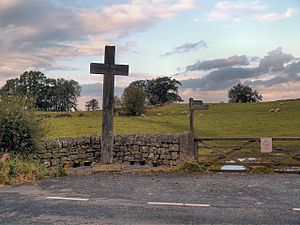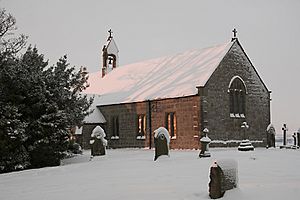Battle of Heavenfield facts for kids
Quick facts for kids Battle of Heavenfield |
|||||||
|---|---|---|---|---|---|---|---|
 Heavenfield: cross and battlefield |
|||||||
|
|||||||
| Belligerents | |||||||
| Kingdom of Northumbria | Kingdom of Gwynedd | ||||||
| Commanders and leaders | |||||||
| King Oswald | Cadwallon ap Cadfan † | ||||||
| Strength | |||||||
| 700 | 1,000 | ||||||
| Casualties and losses | |||||||
| less than 200 killed | 800 killed | ||||||
The Battle of Heavenfield was a major fight in 634. It happened between the Northumbrian army, led by Oswald, and a Welsh army, led by Cadwallon ap Cadfan of Gwynedd. The Northumbrians won a big victory. Old records, like the Annales Cambriae (Annals of Wales), call it Bellum Cantscaul. Another historian, Bede, called it the Battle of Deniseburna near Hefenfelth.
Contents
Why the Battle Happened
An alliance formed between Cadwallon of Gwynedd and King Penda of Mercia. They decided to invade Northumbria. This was a bit unusual, as Cadwallon was a Christian king from a British background. Penda, on the other hand, was a pagan king from an Anglian background.
At the Battle of Hatfield Chase in 633, the Welsh and Mercian invaders defeated Northumbria. They killed the Northumbrian king, King Edwin. After this, Northumbria was split into two smaller kingdoms: Bernicia and Deira. Cadwallon's army then caused a lot of damage across Northumbria.
Eanfrith became king of Bernicia. He had been living in exile before this. Deira was ruled by Osric, who was King Edwin's cousin. Eanfrith's time as king was short. Cadwallon killed him when Eanfrith tried to make peace. According to Bede, Osric was also killed by Cadwallon while trying to attack him.
Eanfrith's brother, Oswald, then returned. He had been in exile for seventeen years in Dál Riata (a kingdom in modern-day Scotland and Ireland). Oswald wanted to claim the Northumbrian crown. But Cadwallon's army was still a threat. Oswald quickly had to gather an army to fight the invaders.
How the Battle Was Fought
The Welsh army likely moved north from York. They followed a Roman road called Dere Street. Oswald, possibly with some Scots soldiers, chose a strong defensive spot. It was next to the Roman Wall, about 4 miles (6.4 km) north of Hexham.
It is said that the night before the battle, Oswald had a vision. He saw Saint Columba, who told him he would win. Oswald positioned his army facing east. Their sides were protected by Brady's Crag to the north and the Roman Wall to the south. Bede wrote that Oswald put up a cross. He then prayed for victory with his soldiers.
The Welsh army probably had more soldiers. However, they had to attack from the east. They were forced into a narrow space between the Wall and Brady's Crag. This meant they couldn't spread out or go around the Northumbrians. We don't know how long the battle lasted or how many soldiers were lost. But the Welsh army eventually broke apart.
The Welsh soldiers ran south, with the Northumbrians chasing them. Many Welsh soldiers were killed as they fled. Bede says that Cadwallon was caught about 10 miles (16 km) south of Heavenfield. He was killed at a place called Denisesburna, which is now thought to be the Rowley Burn (or Rowley Brook).
This battle was a huge win for Oswald. The Welsh likely lost many soldiers. Because Oswald's smaller army won in such an amazing way, the battle site became known as Heavenfield (Heofenfeld). It became a special place for Christians to visit.
What Happened After
After the battle, Oswald brought Deira and Bernicia back together. He became king of all Northumbria. Bede believed that this battle was very important because it brought Christianity back to Northumbria. Oswald ruled Northumbria for eight years. He was then killed in the Battle of Maserfield. Oswald's brother, Oswiu, became the next king of Northumbria.
The Battle Site Today
Today, if you drive east of Chollerford along the Roman Wall (B6318), you will see a wooden cross. This cross marks the spot where the Battle of Heavenfield is believed to have happened. On a hill north of the cross is St Oswald's Church, Heavenfield. This church marks the place where Oswald is thought to have raised his battle standard. The site is about 2.8 miles (4.5 km) east of the River North Tyne.
Some historians suggest another possible location near Devil's Water. Bede called the site Denisesburn. A document from 1233 suggests this is close to Devil's Water. Some believe the battle might have started on the east bank of Devil's Water.


